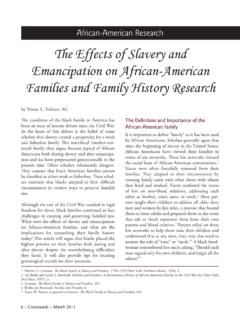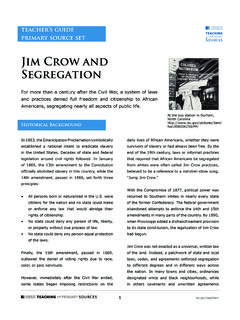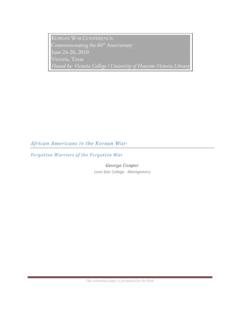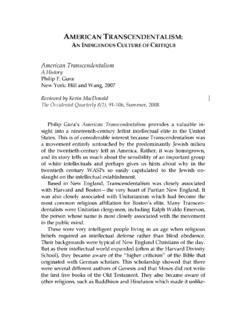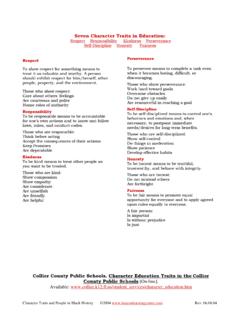Transcription of Roger Ransom The Civil War in American Economic History …
1 Roger Ransom The Civil War in American Economic History -1- The Civil War in American Economic History Roger L. Ransom University of California, Riverside The Civil War was the deadliest war in American History . Almost 3 million men fought in either the Union or Confederate Armies, and as many as 750,000 of them died as a result of the war. Another half million or so more limped home with wounds that left them unable to fully resume their lives after the war. The effort to mobilize resources for the war bankrupted the Confederacy and left a financial burden on the United States Government that lasted well into the twentieth century.
2 Finally, the war dramatically restructured the institutional landscape of the United States by freeing four and half million African American slaves. Writing sixty years after Appomattox, historians Charles and Mary Beard called the Civil War a Second American Revolution which paved the way for the Economic transformation of the United States in the last third of the nineteenth century. Not surprisingly, the History of how this happened has drawn Economic historians into the examination of both the causes and the impact of the war on the course of Economic development of the American economy.
3 This essay examines four questions that economics historians have raised with regard to the economics of the Civil War: 1] Was slavery a significant factor in causing the Civil War? 2] What was the Economic cost of the Civil War? 3] What were the Economic consequences of Emancipation? 4] What was the Economic legacy of the Civil War? The Economics of slavery and the Civil War The political debates over slavery go back to the formative years of the Republic. The Continental Congress had dealt with the most contentious aspect of slavery by enacting the Land Roger Ransom The Civil War in American Economic History -2- Ordinance of 1787 prohibiting slavery north of the Ohio River.
4 Three years later the newly formed Congress of the United States passed a Land Ordinance of 1790 that guaranteed slavery could persist south of the Ohio These two laws seemingly settled the issue over where the western expansion of slavery would be permitted. However, in 1803 the United States acquired the Louisiana Purchase, thus reopening the question of slavery in the western territories. In 1820 the admission a new slave of Missouri caused uproar because Missouri was clearly north of the Ohio River. The resulting compromise drew an imaginary line westward from the Mississippi River to the Rocky Mountains which was meant to serve as a boundary between any future free and slave states.
5 This worked well enough until 1850, when the admission of California as a free state sparked a bitter debate that was resolved only after anti-slave forces agreed to new and more stringent Fugitive Slave Act. In the long run each of these Attempts at compromise made the slave problem worse by encouraging the continued westward expansion of slavery . In 1790 there were already 700,000 slaves living in the United States. This meant that in the Southern States, where most of the slaves lived, about one out of three people were someone else s property.
6 By 1860 there were million slaves in the United States, worth an estimated $3 The Economic tentacles of the slave system had spread into every aspect of life in the South. According to one estimate, one-fourth of the income accruing to all whites in the slave states could be attributed to slave labor in The planters capital invested in slaves by planters represented nearly half of the wealth reported to the census in the major cotton-growing states of the south in 1859. Manufacturing capital amounted to only one percent of the total wealth accumulated in the Roger Ransom The Civil War in American Economic History -3- The stunning Economic success of a system relying on slave labor remained both an embarrassment and a puzzle for Americans who believed that slave labor was not only immoral, but also inefficient when compared to the labor of free men and women.
7 Planters at the time insisted that they lost money planting crops with slave labor, and historians delving into the account books of plantations came to the same conclusion. But if slavery was unprofitable and inefficient , how had it survived indeed prospered in a free market society for over two centuries? The answer is that one must think of slaves as property rather than as people. Slaves are Economic assets that are purchased to obtain a rate of return from the capital investment. In 1958 two young economists, Alfred Conrad and John Meyer, demonstrated that if one included not only the output from slave labor, but also the value of any slave children, then slavery turns out to be quite Five decades of research have not seriously challenged the results obtained from Conrad-Meyer s asset pricing model of slavery .
8 A slaveholder who managed to keep his slaves alive and willing to have children could make at least a normal profit from capital gains alone. A further implication of this model was that slave labor not only made the South a very prosperous region, it also produced powerful pressures for the westward expansion, which continually brought the slave society into contact with free labor that was also moving west. It was this continual intersection of slave and free settlers that fanned the flames of conflict over slavery in the west throughout the antebellum years. The Economic robustness of slavery in the South produced huge rents that accrued to slaveholders.
9 The effect of these rents on the distribution of wealth in the United States can be seen in Map 1 below, which shows the average level of wealth per free person reported for each county of the United States in 1859. Virtually all of the counties reporting an average of $1,500 or more are in the South, and in the areas where slaves were located the reported per capita Roger Ransom The Civil War in American Economic History -4- wealth tended to exceed $5,000 a huge sum in those days. No other sections of the country reported anywhere near this level of wealth per capita.
10 This concentration of wealth strongly was a highly visible reminder of the concentration of power Economic and political in the hands of a small number of very powerful men. To many people in the North, what they referred to as the Slave Power was a sinister group of Southerners who manipulated the national government to their own advantage. INSERT MAP 1 By itself, the accumulation of slave wealth could explain why the South might be willing to take extreme measures including secession and war to protect their property. However, so long as their property was not threatened, Southerners had powerful incentives to remain in an Economic system that was earning them huge rewards.

